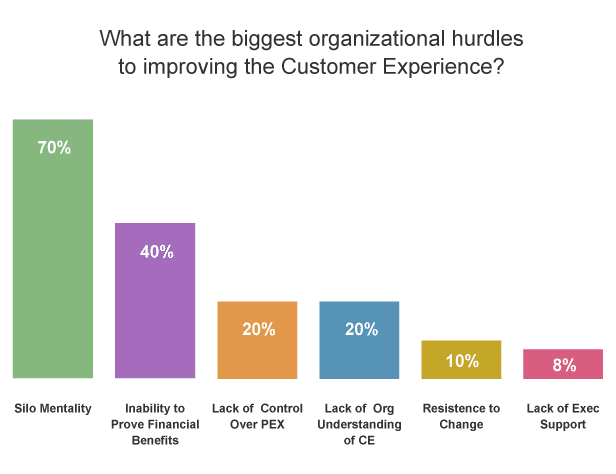A business is very much like a human body, and just like a body, it comprises different parts that all play an active role in keeping the business alive, healthy, and moving forward. When departments constrict communication, stop sharing information and knowledge with one another, the business suffers.
The standard model of organizational structure in a company involves compartmentalization of a business into several departments focused on their own respective objectives. This model, however, essentially leads to departments ignoring one another – a phenomenon referred to as the silo mentality.
In the past, this organizational structure has indeed worked well, but in today’s dynamic world of business, it’s a plague able to destroy a company. Latest studies revealed that companies which model themselves around the silo mentality make it near impossible to improve the customer experience:
 Source: Beyond Philosophy
Source: Beyond Philosophy
But that’s not the only problem the silo mentality causes.
Problem with the silo mentality
SMEs and organizations will often adopt the silo approach unknowingly. As a result, each department is often clueless about what other departments are doing, what goals they are driving towards, or how they are reaching them.
Public relations may be working towards reaching the local people while the HR team is trying to source employees from different cities or countries. Instead of working in unison to achieve the company’s aims, the two departments are focused on their own objectives, never meeting the main goals of the company.
Employees are often rewarded for achieving goals within their silo, regardless of the negative impact, their actions have on other departments and, of course, the company. A department might take one step forward, but the business as a whole takes two steps back, making progress difficult.
Breaking down silos
To break down the silo mentality, 4 essential factors need to be enforced.
Communication flow
Silo walls need to be broken down in favor of open communication channels between various departments. All business-relevant information should be passed on across the whole company.
Aims and objectives aligned
Employees in silos work towards their department’s goals, which only stunts the growth of the business. Goals must be adjusted so that they fit in with the company’s aims and objectives and not the departments’. This can only be implemented via strong communication channels.
Decisions made together
Department decisions tend to be made on the micro level, with little next to no input from other departments. However, when decision making is split across all relevant departments, the flow of communication opens and objectives are more likely to be aligned with the overall needs of the business.
Create a new team to liaise
Leaders and individuals who can spot opportunities, promote change, find and fix potential bottlenecks should be put in charge to ensure there are no kinks in the organizational transformation. In the event of a problem or change, there should be a person or team available for consultation to all departments.
Breaking up silos is not about removing departments or bringing them together under a single umbrella, but about removing friction points that cause conflict and hinder communication flow.
Consolidation may be necessary
One of the underlying problems of silos is that duties of many employees often overlap between different departments. Thus, reshaping parts of the business or consolidating departments may increase cooperation and aid the breakdown of the silo mentality.
For example, today’s marketing roles are very similar to those in public relations; therefore, merging marketing and PR departments into one entity may be a sensible option. In fact, other departments handling sales should be unified to share mutual marketing duties.
Incentivize around common goals
The “it’s not my job” statement so often voiced by employees when they are asked to do something outside the scope of their silo usually means their silo’s goals are not aligned directly with the company’s. Employees should be rewarded and praised for reaching company-oriented goals over silo’s objectives.
For example, if a company wishes to increase its brand image, the customer service reps may receive incentives for providing 95% customer satisfaction, while the marketing team may be rewarded for increasing engagement through content marketing.
Incentive rewards are just one method to align goals. Employees also respond well to praise and opportunity of self-development in the future.
How to know if your business suffers from the silo mentality?
There are four traits that show whether a business is plagued with the silo mentality:
Inability to scale ideas and initiatives
If new changes and ideas at the company fail often, silos are usually the root cause of the problem.
Customers receiving an inconsistent message
When department goals aren’t aligned, silos have been known to spread different information and values to customers. This results in a clouded brand message, leaving customers confused about a business.
Employees don’t care for the brand
Ignoring to follow company procedures or voicing the “it’s not my job” remark are red flags meaning that employees don’t feel connected to the business, and are focusing on short-term goals that favor their silo.
Silo rivalry
Splitting humans into groups often creates rivalry and breeds an “us vs. them” mentality. These internal rivalries can quickly turn toxic and completely destroy the communication flow between silos. Team building exercises can diffuse rivalries and form bonds between different departments.
Summary
Silos have been viewed as a thorn in the side of the businesses for a while now, but they aren’t something that can be surmounted. It’s down to the CEOs and executive leaders to break down the silo mentality and adequately train and transform the mindset of the departments.
Breaking down and rebuilding the structure of an organization is not an easy thing to achieve, but by using the tips listed in this article, businesses can begin to change their company mindset and structure. A business which has all its departments working towards a singular goal is unstoppable.


